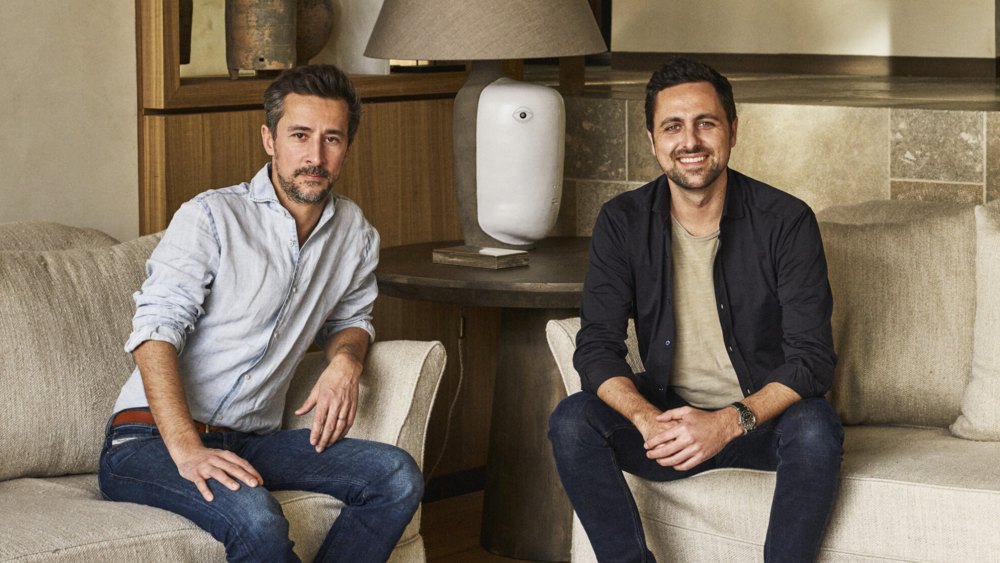Cannes, quite famously, has a Palais, an imposing white structure that houses the film festival and market.
But the city’s historical crown jewel lies a little bit east on the quieter side of the Boulevard de la Croisette at the Palm Beach, the Belle Epoque palace that will reopen Tuesday following a three-year transformation to restore it to its former glory.
In a complete overhaul of the space costing upward of 120 million euros, the Palm Beach has been redesigned by architects Caprini & Pellerin, the namesake agency of Kevin Caprini and Jerry Pellerin, and transformed into a luxury entertainment hub that will host high-end restaurants, boutiques and a cabaret, as well as a members’ only pool, cocktail lounge and concierge service.
“When you have such an iconic building, you feel very responsible, and even more when you’re from Cannes. I’ve been living with this building since my childhood,” Pellerin told WWD. “When you design these kinds of projects you don’t design only as an architect, [but] with a consciousness to feel the history and the evolution of this building.”
The local firm began with a deep dive into the city’s archives and the Palm Beach’s building plans, and also convened meetings with local residents, who shared memories.
“The plans show you things, but it was most important for us to get direct feedback from many people who saw this building, so we went to the 90-year-old neighbors, to friends of my father, and all through the generations in Cannes and they all had a story to tell,” he said.

The Palm Beach was once an architectural wonder that welcomed world leaders including British Prime Minister Winston Churchill and U.S. President John F. Kennedy.
In its heyday, Hollywood stars including Grace Kelly, Ingrid Bergman, Cary Grant and Jerry Lewis played there, and it was immortalized in the 1963 French heist movie “Any Number Can Win” starring a dapper Alain Delon.
Originally built as a seasonal summer casino in 1929 by architect Roger Séssal, the building was meant to be temporary, much like some now-famous Parisian landmarks.
“It was supposed to be demolished,” said Pellerin, comparing it to two other buildings that were once slated for a similar fate. “The Parisians have their Eiffel Tower and Grand Palais, and the Cannois have the Palm Beach.”
It was bombed during World War II, and with additions it grew in square feet, if not glamour. The pool had long been buried. In later decades it was given a series of questionable facelifts by successive owners, rendering it a boxy structure housing a casino and cavernous club. It was, in a word, cheesy.
Caprini and Pellerin set out to unlock these puzzle pieces and restore its luxury roots.
LVMH Moët Hennessy Louis Vuitton is already on board: its Dior and Loro Piana brands will open boutiques in the center’s shopping arcade. Dior will first inaugurate a Dioriviera pop-up for the summer, with a more permanent boutique planned for later in the year. Loro Piana’s plans are still in the works, while 11 other boutiques are to follow.
The architects set out to make the Palm Beach a unique entertainment venue, and it was envisioned to be complimentary to the developments in the rest of the city.
“Cannes didn’t need another hotel, and this is the first luxury entertainment hub in France,” said Pellerin. “It’s something that is not only a signature, but somewhere with an atmosphere. The journey through time will be amazing and the service will be at the top level.”

The new Cannes location of nearby Nice’s La Petite Maison features among the restaurants, alongside the first French outpost of Rainer Becker’s Zuma, Italian eatery Il Grande and local institution Le Masque de Fer.
Medusa will open as a cabaret, with Cirque de Soleil-style entertainment that will transform into an upscale club later in the night, Tamarin will host a new beach area while Mykonos-based hospitality group Nammos will take over the pool.
“We completely re-approached it with the codes of the Belle Epoque and Art Deco, mixed with the Hispano-Moorish style. We completely recreated the shape and details,” said Pellerin. “We took the codes — they were a gift, you know — and used them to create new things, feeding the architecture and proving our creativity based on the heritage.”
The architects kept the volume of the 250,000-square-foot space while essentially gutting the inside and recreating from the ground up.
“The main corridor was very closed. It had a bit of a dark mood and the ghosts of the gamblers,” he joked. The architects opened it up to bring in sea and sun.
Arches abound, inspired by St. Mark’s Basilica in Venice. They used marble from India, Italy and Iran throughout. The architects emphasized French stone in the passageways, using limestone from Burgundy on the terraces and walkways, while the shopping arcade boasts exposed raw travertine. Raffia walls also feature throughout.

The duo reinterpreted terrazzo, traditionally constructed of small, hand-cast stones, in a grander scale fitting with the building’s massive size.
The facade has been reworked and recalls the original Hispano-Moorish style with minarets reaching skyward like a crown, while cornices are perched on the roof. Parts of the building are covered in a metal mesh that will facilitate twinkling light shows.
The 10,075-square-foot central events hall is poised to be an alternative venue during the film festival, when studios or production companies want to escape the bunker-like basement of the Palais. It’s got an expansive, 360-view on the sea; the architects added frescoes.
The team also demolished and completely rebuilt the Riviera’s only saltwater pool of nearly Olympic proportions at 142 feet. It will now be a members-only club.
That’s where luxury steps in again, with a Palm Beach membership granting special access, such as priority and last-minute reservations, access to the private speakeasy that has been faithfully recreated based on the original bar, as well as a concierge and driver service. An upcoming fitness club also features.
The concierge desk sits center stage. “We made a dramatic approach, a little bit like ‘Grand Budapest Hotel,’ a little bit of Wes Anderson,” for the post.

It’s all part of Cannes mayor David Lisnard’s ongoing overhaul of the city, Pellerin noted, as he has spearheaded a series of mandated changes, including investment and architectural specs along the Croisette and other pedestrianized streets, throughout his tenure.
The new Palm Beach follows the reopening of another historical gem: the century-old Carlton hotel was revamped last year. Other projects have included the harmonization of the Croisette beachside bars and restaurants, the refresh of the town’s main square on the Promenade de la Pantiero and the pedestrianization of rue d’Antibes near the old town. Plus there’s been other new builds: Hotel Belle Plage, for example.
“There’s a new atmosphere in Cannes and we are growing,” Pellerin said. The world’s collective image of Cannes did not match the reality, and the new luxury developments hope to bring back some sparkle.

About 50 percent of the facilities will be open at festival time. Some are slated to open later this year, with phase two of the facility on track for 2025.
The official opening will coincide with the first day of the film festival, with private cocktails, such as Dior’s, scheduled throughout the week.
“It’s Riviera chic,” added Pellerin. “It’s contemporary because of the lighting and the technical codes, but once you are inside there is a timeless feeling. Our mindset was always to consider the history of this building and what it has been. It’s a ‘retro-future’ project. We took the past and brought it forward.”



